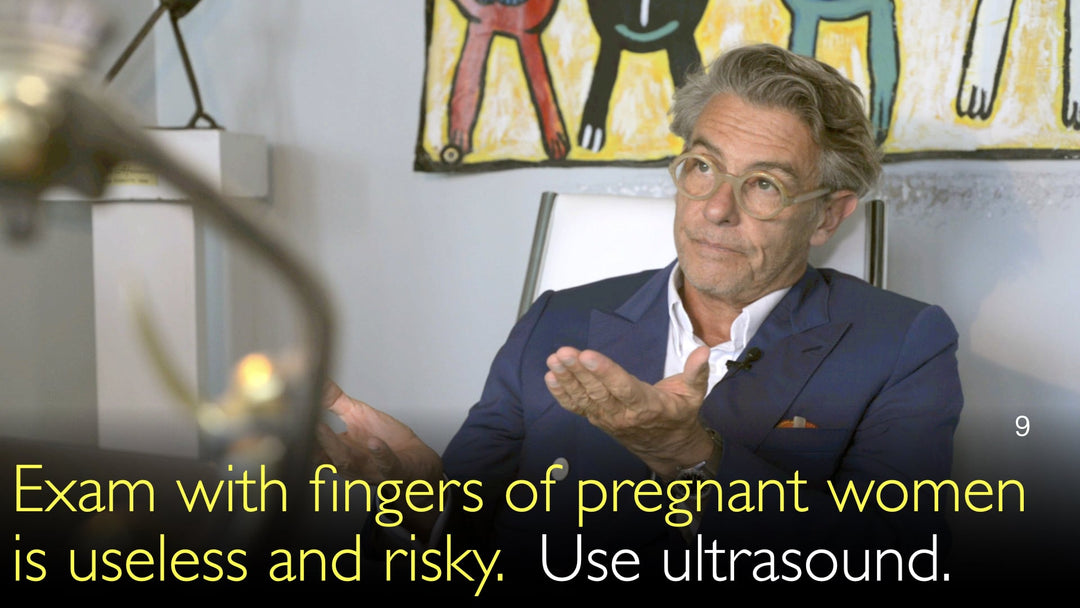Leading expert in maternal-fetal medicine, Dr. Yves Ville, MD, explains why digital cervical exams are outdated and risky. He details how transvaginal ultrasound provides superior, objective measurement of cervical length to predict preterm birth risk. Dr. Ville also discusses the critical role of MRI in diagnosing complex placental conditions like placenta accreta, offering unparalleled anatomical detail for safer pregnancy management.
Modern Prenatal Care: Replacing Digital Exams with Ultrasound and MRI
Jump To Section
- The Dangers and Inaccuracy of Digital Cervical Exams
- Transvaginal Ultrasound for Preterm Birth Prediction
- Understanding Predictive Value in Cervical Assessment
- MRI for Detailed Fetal and Placental Anatomy
- Diagnosing Placenta Accreta Spectrum with MRI
- The Future of Functional Imaging in Pregnancy
- Full Transcript
The Dangers and Inaccuracy of Digital Cervical Exams
Dr. Yves Ville, MD, states that digital examination of the cervix is a centuries-old practice that should be abandoned during pregnancy. He emphasizes that this method is useless outside of active labor. The procedure is fraught with inaccuracies, producing both false positive and false negative results.
More critically, Dr. Yves Ville, MD, highlights the significant infection risk associated with a digital exam. He explains that an apparently long cervix can actually be open internally, and introducing fingers can colonize the membranes with bacteria. Furthermore, a cervix can feel short to the touch but be measured as long on an ultrasound, demonstrating the method's fundamental unreliability.
Transvaginal Ultrasound for Preterm Birth Prediction
Dr. Yves Ville, MD, champions transvaginal ultrasound as the objective gold standard for assessing preterm birth risk. This imaging technique accurately measures cervical length and can identify critical changes, such as funneling, where the internal opening of the cervix begins to dilate. Ultrasound provides a clear, visual assessment that is impossible to achieve with a physical exam.
Dr. Anton Titov, MD, discussed this advancement with Dr. Ville, who noted its particular importance for high-risk pregnancies. For women with a history of prematurity or those carrying twins or triplets, a long cervical measurement on ultrasound offers tremendous reassurance. This objective data is proven superior to digital examination in numerous clinical studies.
Understanding Predictive Value in Cervical Assessment
A key strength of ultrasound, as explained by Dr. Yves Ville, MD, is its excellent negative predictive value. When the cervical length is long, the likelihood of delivering prematurely is extremely low. This provides critical peace of mind for patients and clinicians managing high-risk scenarios.
Dr. Ville clarifies that while ultrasound is far better than a digital exam, a short cervix alone does not always guarantee preterm labor. The positive predictive value is not as strong. This has led to research into complementary diagnostic tests, like fetal fibronectin, to improve the accuracy of predicting which women with a short cervix will actually go into early labor.
MRI for Detailed Fetal and Placental Anatomy
During the interview with Dr. Anton Titov, MD, Dr. Yves Ville, MD, detailed the two primary applications for MRI in pregnancy: morphology and function. For anatomical detail, MRI is an extremely accurate tool, especially for imaging the fetal brain in the third trimester. Its clarity is much better than ultrasound in late pregnancy.
Dr. Yves Ville, MD, notes that MRI provides the best negative predictive value for ruling out brain abnormalities, particularly following a suspected fetal infection. While ultrasound currently outperforms MRI in assessing placental function using Doppler technology, MRI is rapidly developing its capabilities for functional imaging of the brain, placenta, and other organs.
Diagnosing Placenta Accreta Spectrum with MRI
Dr. Yves Ville, MD, identifies MRI as a pristine tool for diagnosing placenta accreta spectrum disorders. This life-threatening condition occurs when the placenta invades the uterine wall too deeply, lacking a normal cleavage plane. The spectrum includes placenta accreta, increta, and the most severe, percreta, where the placenta invades through the uterine wall.
Dr. Yves Ville, MD, explains that MRI is especially crucial when the placenta is located on the posterior uterine wall, where ultrasound is less effective. The scan can clearly show the depth of invasion and assess involvement of nearby maternal blood vessels. This detailed anatomical information is a vital prognostic factor for surgical planning and can also definitively exclude the diagnosis to alleviate patient anxiety.
The Future of Functional Imaging in Pregnancy
The discussion between Dr. Anton Titov, MD, and Dr. Yves Ville, MD, looked toward the future of prenatal imaging. While MRI's anatomical applications are firmly established, its functional role is still evolving. Research is ongoing to use MRI to explore brain function and detailed placental perfusion.
Dr. Ville concludes that the integration of these advanced imaging modalities represents the new standard of care. Replacing subjective digital exams with objective ultrasound and MRI leads to more accurate diagnoses, better risk stratification, and ultimately, safer outcomes for both mother and child.
Full Transcript
Dr. Anton Titov, MD: You are also an expert in the prevention of preterm birth. You published important research using transvaginal ultrasound examination to measure cervical length. This can predict the risk of premature rupture of membranes, premature birth, and some serious complications for the mother and the child. Please discuss your work in the prevention of preterm labor and premature birth.
Dr. Yves Ville, MD: Right. Obstetrics for centuries, thousands of years, is based on digital examination of the cervix, which is the worst thing that we could come up with. It's useless during pregnancy. It is less used in the Anglo-Saxon world, and that's a very good thing.
I think no pregnant woman should ever be examined digitally during the pregnancy. The only advantage of a digital examination of the cervix is when a woman is in labor. Outside this situation, this is full of false positive and false negative information.
Digital examination of the cervix increases the risk of infection. It increases the risk of infection because a long cervix can be entirely open and colonized by the membranes from inside, and your digital examination will be normal.
A cervix can seem short with your fingers and be long by ultrasound with an internal os that is very high up. And once a woman has delivered once in her life, a cervix is never closed again. Therefore, saying that, "Oh yeah, I can't put my finger in," certainly don't do that. And if you do that, it doesn't prove anything.
So ultrasound came up as the most objective examination about the risk of prematurity. A short cervix or a cervix that is open, it is called a funneling from the inside, although it's long, can be high risk. Ultrasound is very accurate for that.
Also, and most importantly, in a high-risk situation, women with a previous history of prematurity, women with twins or triplets, if the cervix on ultrasound is long, then the negative predictive value of delivering prematurely is extremely high.
So ultrasound is proven in many clinical studies to be superior to digital examination, and to have an excellent negative predictive value. It's only when a cervix is short and there are contractions. If the cervix is short with ultrasound, although it's better than digital examination, the positive predictive value is still not that high.
So people have worked on a complementary diagnostic test for that. Fibronectin and other things to try and improve the positive predictive value for premature labor. But the negative predictive value of ultrasound is excellent.
So ultrasound in obstetrics has become a clinical tool. Even if it's an oxymoron because it's a device, it's not clinical. It is the best clinical examination is vaginal ultrasound in obstetrics.
Dr. Anton Titov, MD: Thank you, that's very important information. You're also a leading expert on MRI in the diagnosis of problems during pregnancy, both for the unborn mother and developing child. An MRI of the placenta can identify important risk factors for the developing fetus, for the mother, and for the future child. How can MRI be used for the diagnosing of problems in the placenta? And what is the future for MRI use in diagnosing problems during pregnancy?
Dr. Yves Ville, MD: Schematically, there are two kinds of expectations for MRI. One expectation is about morphology. The other one is about function. For morphology, MRI is an extremely accurate tool. Both for the fetal anatomy and especially the brain, MRI is unbeatable, much better than ultrasound, especially late in the pregnancy.
And if you look at function, today ultrasound is much more accurate than MRI in predicting functional problems with the placenta, for example, by using Doppler, umbilical and fetal Doppler. MRI is currently developing in exploring the function of the brain, function of certain organs, and function of the placenta.
But to date, MRI has not achieved a clinical level of performance. Although if you look at, again, the anatomy, the anatomy of the brain, the fetal brain in a high-risk situation, we mentioned infections earlier on, MRI has the best negative predictive value. Clearly.
Now, MRI of the placenta is extremely useful and accurate if you suspect placenta accreta or if you have risk factors for placenta accreta. So, placenta accreta is a placenta inserted not on the surface of the uterus with a cleavage plane, represented by the endometrium. It is going through the endometrium, at a different level of penetration of the uterus, sometimes down to the serosa.
So you got placenta accreta, placenta increta, placenta percreta. Especially when the placenta is posterior, ultrasound is not the best tool for diagnosing placenta accreta. But MRI is pristine to show you either placenta accreta, increta, or percreta.
You can look at the invasion of the nearby vessels in the pregnant woman, which is a very important prognostic factor for the management and mainly to exclude placenta accreta, actually. You can say, "No, don't worry, this placenta looks odd on ultrasound, but there is no placenta accreta."







